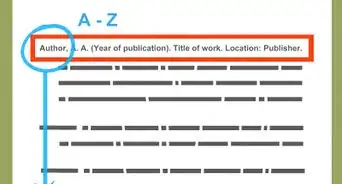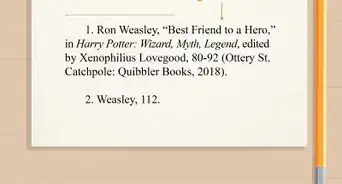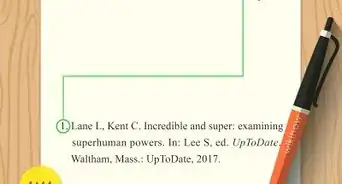This article was co-authored by wikiHow staff writer, Jennifer Mueller, JD. Jennifer Mueller is a wikiHow Content Creator. She specializes in reviewing, fact-checking, and evaluating wikiHow's content to ensure thoroughness and accuracy. Jennifer holds a JD from Indiana University Maurer School of Law in 2006.
There are 7 references cited in this article, which can be found at the bottom of the page.
This article has been viewed 310,121 times.
Learn more...
Depending on the type of paper you're writing, you may need to use a song as a reference – either a specific recording, or the composition of the song itself. The format of your citation will be somewhat different depending on whether you are using Modern Language Association (MLA) style, American Psychological Association (APA) style, or the format in the Chicago Manual of Style. You'll also need a brief, in-text citation to point the reader to the more complete citation at the end of your work.[1]
Steps
Using MLA
-
1Use the name of the performer to cite recordings. The basic MLA citation starts with the name of the author. In the case of a song, if you're referencing a particular recording, the performer is the author.
- The performer could be a single individual or a band. If you're using the name of a single person, use "last name, first name" format.
- For example: Knowles-Carter, Beyoncé.
-
2Use the name of the composer for compositions. If you're citing a piece of sheet music rather than a recording, the first name in your MLA citation should be the composer or songwriter of the piece of music.
- If there are multiple writers, list them all in the order they appear in the copyright information for the song. If the song has lyrics, there may be both a composer and a lyricist.
- For example: Knowles-Carter, Beyoncé and James Blake.
Advertisement -
3Provide the name of the song. The name of the song you've referenced is the next piece of information in your MLA citation, whether you're citing a recording or a piece of music. Enclose it in quotation marks.
- For example: Knowles-Carter, Beyoncé and James Blake. "Freedom."
-
4Include publication or recording information. Following the song title, provide the title of the album for recordings, along with the record company and the year the album was released. For sheet music, provide the title of the book in which the music appears, the name of the company that published the sheet music, and the year it was published.
- For example: Knowles-Carter, Beyoncé and James Blake. "Freedom." Lemonade, Parkwood Entertainment, 2016.
-
5List the format and method of access. If you're citing a piece of sheet music, this is as simple as adding the words "sheet music" to the end of your citation. For recordings, list the format you accessed specifically. If you accessed the music online, include the date you accessed it.
- For example: Knowles-Carter, Beyoncé and James Blake. "Freedom." Lemonade, Parkwood Entertainment, 2016. Online, www.beyonce.com/album/lemonade-visual-album/, accessed January 9, 2017.
-
6Provide the name of the artist or composer for in-text citations. Whenever you mention the song in your paper, you'll need a parenthetical citation to direct your readers to the full citation in your "Works Cited" at the end of your paper.
- Use the name you used in your full citation. Just use the first or primary name if there is more than one artist in the full citation. Include the title or a title phrase if you're citing more than one work by that artist.
- For example: (Knowles-Carter, "Freedom")
Using APA
-
1Start with the name of the songwriter or composer. When citing a recording in APA, the song is listed with reference to the songwriter. List their last name followed by their first initial. If there is more than one songwriter or composer listed, include all names.[2]
- For example: Knowles-Carter, B., & Blake, J.
- If there are multiple writers and their roles are identified, you can put these in parentheses after their names. For example: Knowles-Carter, B. (Lyricist), & Blake, J. (Composer).
-
2Add the copyright year. You can find the copyright year of the album on the back of a physical album or in the legal information for the album if you access the song online. Typically the date you need will follow a © copyright symbol.[3]
- For example: Knowles-Carter, B., & Blake, J. (2016).
-
3List the title of the song. Capitalize and punctuate the song title exactly as it appears on the album or sheet music. If you're citing a recording of the song that was done by someone other than one of the songwriters, include that information in brackets after the song title.[4]
- You also may want to include the name of the performing artist if they are known by a stage name or are otherwise not immediately identifiable by their last name.
- For example: Knowles-Carter, B., & Blake, J. (2016). Freedom [Recorded by Beyoncé].
-
4Provide the name of the album and medium. After the title of the song, start a new sentence with the word "On" and then provide the name of the album in italics. If you're citing a recording (rather than sheet music), include information about the medium (typically CD or LP).[5]
- For example: Knowles-Carter, B., & Blake, J. (2016). Freedom. On Lemonade [CD].
-
5List publication or recording information. For sheet music, you'll use the location and name of the publishing company, typically found with the copyright information on the inside cover. The location and record company for a recording can be found on the back of an album or online. Include the year of recording in parentheses, even if it is the same as the copyright year.[6]
- Include state or country information if the city is not well-known. Otherwise, simply include the name of the city.
- For example: Knowles-Carter, B., & Blake, J. (2016). Freedom. On Lemonade [CD]. New York City: Parkwood Entertainment (2016).
-
6Use the songwriter, copyright year, and track number for in-text citations. Whenever you mention the song in your paper, you need a parenthetical citation that will direct your readers to the full citation in your references at the end of your paper.[7]
- For example: (Knowles-Carter & Blake, 2016, track 10)
Using Chicago Style
-
1Start with the name of the songwriter or composer. In Chicago style, you must list all songwriters or composers, whether you're citing a piece of sheet music or a recording. List names with the last name first, followed by the first name. List additional writers' names in regular "first-name last-name" order.[8]
- For example: Knowles-Carter, Beyoncé, and James Blake.
-
2List the title of the song. In Chicago style, the song title is italicized and comes immediately after the names of the songwriters. You can include the album title as well, if applicable, but it isn't strictly necessary. If you reference more than one song on the album in your paper, simply cite to the album as a whole in your bibliography.[9]
- For example: Knowles-Carter, Beyoncé, and James Blake. Freedom.
- If the performer of the song is someone different from the songwriters, include this information immediately after the title of the song or album by listing their first name and last name.
- If the performer is more important than the songwriter or composer, you may want to list their name first. Use your best judgment depending on the focus of your paper.
-
3Provide publication or recording information. For sheet music, include the location and name of the publisher and the year of publication. If you're citing a recording, provide the name of the record label followed by the recording number and the copyright year.[10]
- If you can't find the recording number on the physical copy of the recording itself, look on www.discogs.com. Make sure you have the listing for the same recording as the one you're referencing.
- For example: Knowles-Carter, Beyoncé, and James Blake. Freedom. On Lemonade. Parkwood Entertainment, 88985336822, 2016.[11]
-
4List the format and access information. If you're citing a recording, you need to tell your readers which format you accessed. If you accessed the recording digitally, include information about where you accessed it, along with the date you accessed it.[12]
- For example: For example: Knowles-Carter, Beyoncé, and James Blake. Freedom. On Lemonade. Parkwood Entertainment, 88985336822, 2016, CD.
-
5Use author-date style for parenthetical citations. When using Chicago in a professional setting, footnotes typically are preferred. However, if you're turning your paper in at school you may be expected to place parenthetical citations in-text after you reference the song.[13]
- For example: (Knowles-Carter 2016).
- To provide a pinpoint citation to a specific song, include the track number. For example: (Knowles-Carter 2016, track 10).
Community Q&A
-
QuestionPlease clarify how I cite a composer and lyricist. Which comes first? Are there standard abbreviations to distinguish them?
 Community AnswerI would put the composer first and lyricist second. For example, Bacharach and David.
Community AnswerI would put the composer first and lyricist second. For example, Bacharach and David. -
QuestionWhat if the performer is a band, rather than a singular artist?
 Community AnswerYou can just use the band name.
Community AnswerYou can just use the band name.
References
- ↑ http://pitt.libguides.com/citationhelp
- ↑ http://blog.apastyle.org/apastyle/2011/12/how-to-cite-recorded-music-in-apa-style.html
- ↑ http://blog.apastyle.org/apastyle/2011/12/how-to-cite-recorded-music-in-apa-style.html
- ↑ http://blog.apastyle.org/apastyle/2011/12/how-to-cite-recorded-music-in-apa-style.html
- ↑ http://blog.apastyle.org/apastyle/2011/12/how-to-cite-recorded-music-in-apa-style.html
- ↑ http://blog.apastyle.org/apastyle/2011/12/how-to-cite-recorded-music-in-apa-style.html
- ↑ http://www.ubishops.ca/wp-content/uploads/APAguide6thofficial.pdf
- ↑ http://libguides.depauw.edu/c.php?g=73436&p=472435
- ↑ http://libguides.depauw.edu/c.php?g=73436&p=472435
- ↑ http://libguides.depauw.edu/c.php?g=73436&p=472435
- ↑ https://www.discogs.com/Beyoncé-Lemonade/release/8486714
- ↑ http://libguides.depauw.edu/c.php?g=73436&p=472435
- ↑ http://www.press.uchicago.edu/books/turabian/turabian_citationguide.html
- ↑ http://www.easybib.com/guides/citation-guides/chicago-turabian/how-to-cite-a-musical-recording-chicago-turabian/
- ↑ http://www.easybib.com/guides/citation-guides/chicago-turabian/how-to-cite-a-musical-recording-chicago-turabian/
About This Article
To cite a song using APA, start by putting the last name of the songwriter or composer, followed by their initials. Then, add the copyright year in parenthesis, and the title of the song. Next, start a new sentence with the word “on,” followed by the italicized name of the album and the medium you heard it on. End the citation with the location, the name of the recording company, and the recording year. For more information on citing songs, including in-text citations for MLA and Chicago style, read on!

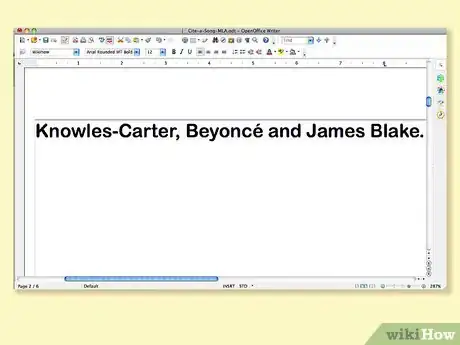





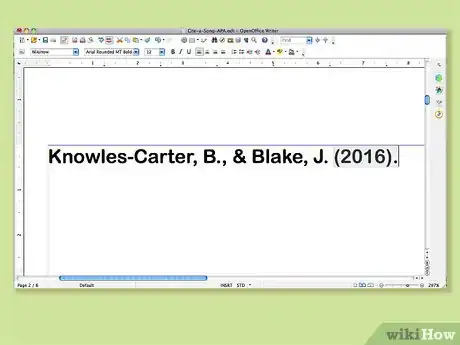





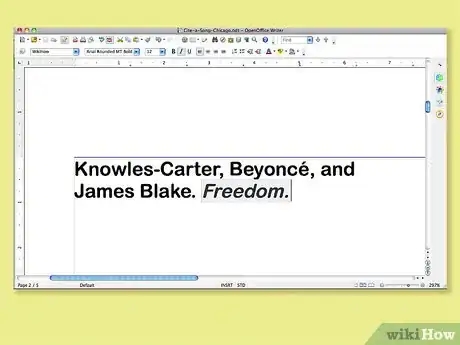


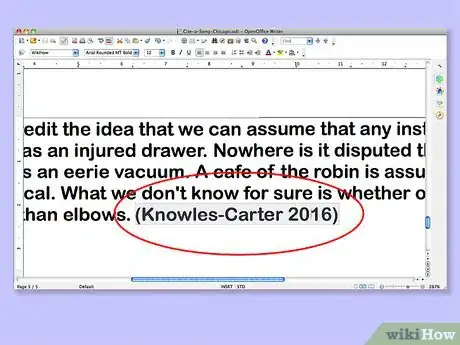



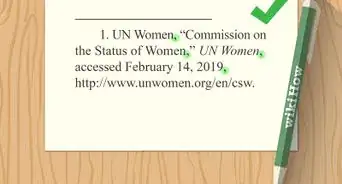



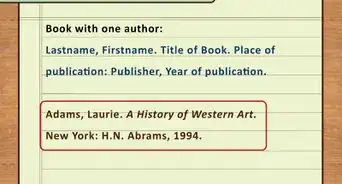

-Step-18.webp)

